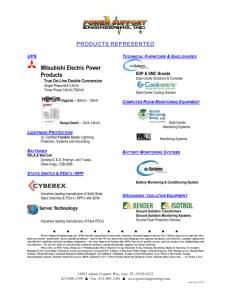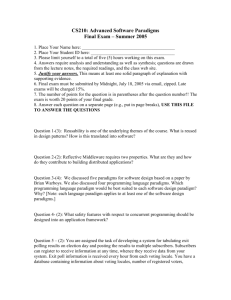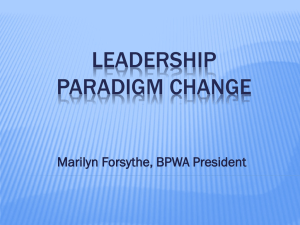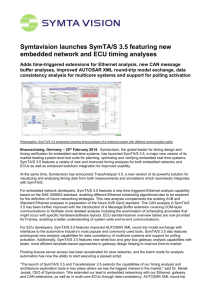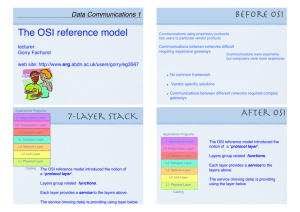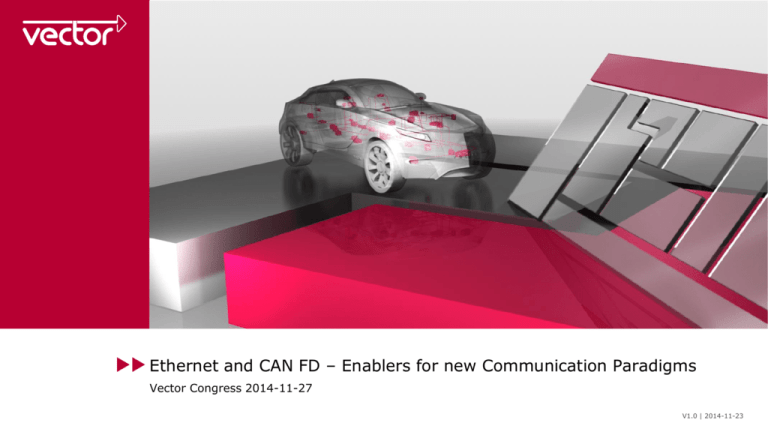
Ethernet and CAN FD – Enablers for new Communication Paradigms
Vector Congress 2014-11-27
1/6
V1.0 | 2014-11-23
Agenda
Introduction
New Communication Paradigm for CAN FD
New Communication Paradigms for Ethernet
Effects on the Database
Summary
2/15
Introduction
Signal- and PDU-based Communication
CAN, LIN and FlexRay are the dominant automotive network technologies
Communication matrix is statically defined in a database
Sender and receiver relations per bus/network
R
FIBEX
R
Signals, PDUs and frames (classically all with static length)
Mapping of signals onto PDUs and mapping of PDUs onto frames
>
Meaningful mapping of signals onto PDUs is already a complex task (max. 8 bytes payload for CAN)
Signals
3/15
R
LDF
AR
Sys.
Desc.
CAN
S
DBC
PDU
Frame
New Communication Paradigm for CAN FD
CAN FD (Flexible Data Rate)
CAN FD is an improved CAN protocol
Higher bit rates for data bytes (Mode 1)
Arbitration-Phase – same bit rate as classic CAN
Data-Phase – bit rate up to ~8 Mbit/s (theoretical value)
CAN
Head
CAN FD
Head
4/15
1
2
2
3
3
4
5
4
6
5
7
8
7
8
6
7
8
Tail
Tail
Up to 64 bytes of payload per frame (Mode 2)
CAN FD
1
Head
1
2
3
4
5
6
…
58
59
60
61
62
63
64
Tail
Definition of long PDUs with corresponding signal mappings is still possible
Creation of communication matrix becomes more complex (up to 64 instead of 8 bytes payload)
New Communication Paradigm for CAN FD
Possible Scenario for CAN FD Introduction
Existing CAN network
CAN
CAN
5/15
Gateway
Bus load limit reached for classic CAN
CAN FD
Requirements for the replacement of CAN by CAN FD
Use the benefit of CAN FD as much as possible (64 bytes payload)
Modify the existing communication matrix as less as possible
Don’t make the gateway much more complex than before
New paradigm: Dynamic Multi-PDU-to-Frame mapping
Reuse already defined (CAN) PDUs
Transmit multiple (CAN) PDUs in one CAN FD frame
New Communication Paradigm for CAN FD
New Paradigm: Dynamic Multi-PDU-to-Frame Mapping
PDU1
PDU2
Gateway
CAN
CAN
HPDU2
PDU1
PDU2 PDU4
PDU2
H PDU4
PDU3
H
PDU3
PDU1 H
PDU4
PDU1
CAN FD
PDU4
PDU3
ECU (e.g. gateway) collects PDUs and transmits them in one CAN FD frame
The order of PDUs within the frame is arbitrary to use the available bandwidth efficiently
Requires additional header information
Different frame triggerings maybe necessary
6/15
Still an easy change
New Communication Paradigm for CAN FD
New Paradigm: Dynamic Multi-PDU-to-Frame Mapping
The feature was added in AUTOSAR 4.2.1
7/15
S
Realized in the IPDU Multiplexer (IpduM)
Network independent
Contained PDU-to-Container PDU mapping
Different Container PDU (frame) triggerings
Container PDU threshold exceeded
Container PDU timeout
Contained PDU timeout
High-priority Contained PDU
First Contained PDU triggers
Two different header formats
4 bytes header (3 bytes ID, 1 byte length)
8 bytes header (4 bytes ID, 4 bytes length)
Application
4.
RTE
COM / LDCOM
1
5.
PDUR
2
3
4
Container PDU
IPDUM
1.
2.
3.
CAN
Stack
FR
Stack
ETH
Stack
New Communication Paradigms for Ethernet
Network Topologies
CAN (FD)
FlexRay
S
R
R
S
S
R
R
Ethernet
S
R
R
Bus
Broadcast
>
Intelligent
receiver
Active star
Broadcast
>
Intelligent
receiver
S
Fully switched
network
(point-to-point)
Unicast
>
Multicast and broadcast
>
8/15
Intelligent sender
Intelligent receiver
R
R
New Communication Paradigms for Ethernet
New Paradigm: Dynamic Multi-PDU-to-Frame Mapping
Ethernet comes along with …
… up to 1500 bytes of payload per frame
… the possibility of unicast communication
New paradigm: Dynamic Multi-PDU-to-Frame mapping
Assemble frames with receiver-specific
content if unicast communication is used
>
>
Efficient usage of the bandwidth
Reduce processer load at receivers
Realization in AUTOSAR by the
Socket Adaptor (SoAd) module
>
IpduM can be used as well but SoAd
offers more options with respect to dynamic
configuration of communication paths
S
1.
Application
RTE
2.
3.
COM / LDCOM
PDUR
1
5.
2
Socket 1
1
2
3
4.
R
Socket 2
2
3
Socket 3
SOAD
(incl. Ethernet Stack)
9/15
R
4.
R
New Communication Paradigms for Ethernet
New Paradigm: Service-Oriented Communication (1)
Build up communication relationships during runtime
Don’t send meaningless data and send data only when
there is a need
Reduce bandwidth usage
Save processing resources at sender and receiver side
The location of the sender shall be flexible
Variant handling
C
S
Offer service
Call method
Get return values
Offer service
Service Discovery
What is a service?
>
>
10/15
Methods: Remote Procedure Calls
Events: Publish/Subscribe, get notifications automatically
Service provider (server): Announce the availability and
location of an offered service (broadcast)
Service consumer (client): Subscribe to event groups to
get notifications
Subscribe to event group
Get notifications
New Communication Paradigms for Ethernet
New Paradigm: Service-Oriented Communication (2)
Data serialization
Today, signals are “serialized” statically to fit the
PDU layout specified in the database
Especially in the ADAS domain, there are more and
more data elements of dynamic length
E.g. object data of a complex sensor
>
Signals
PDU
Number of recognized objects varies during operation
A static PDU layout has to consider the worst case scenario
>
DB
In most cases, a lot of “empty” signals are transmitted
PDU
(Byte stream)
Structured data
struct
Scalable Service-Oriented Middleware over IP (SOME/IP)
(De-)Serialization of signals during runtime
>
>
>
11/15
Signals and PDUs of dynamic length
Don’t specify all signals and the PDU layout in a database
Transmit only the relevant and currently available data elements
>
Save bandwidth
>
Save computing resources
uint32 val1
float32 val2
int8 arr[1..9]
uint8 val3
SOME/IP
val1_1
val1_2
val1_3
val1_4
val2_1
val2_2
val2_3
val2_4
arr len
arr_1
arr_2
val3_1
New Communication Paradigms for Ethernet
New Paradigm: Service-Oriented Communication
Realization of Service Discovery and SOME/IP in AUTOSAR 4.2.1
Example: Server sends event notification
1. Service Discovery communication to handle service offer
and event group subscription (interaction with SW-C over BSWM)
S
SW-C
1.
3.
RTE
4. SOMEIPXF
BSWM
LDCOM
SD
2.
PDUR
5.
SOAD
(incl. Ethernet Stack) 6.
12/15
2. Service Discovery configures communication paths in the
Socket Adaptor (PDU-to-Frame/Socket mapping)
3. Software Component (SW-C) sends signals (structured data)
4. Structured data is serialized in the RTE transformer (SOMEIPXF)
and SOME/IP header information is added
5. Socket Adaptor adds second part of SOME/IP header
information (PDU header for dynamic Multi-PDU-to-Frame mapping)
6. Socket Adaptor decides when to send a frame, based on the
different frame triggering options
Effects on the Database
AUTOSAR System Description
AUTOSAR 4.2.1
Dynamic Multi-PDU-to-Frame mapping
1. General approach for IpduM
2. Ethernet-specific in the Socket Adaptor (extensions for service-oriented communication)
Service-oriented communication
>
>
There is no other database format offering the same possibilities as the AUTOSAR System
Description
>
13/15
Service Discovery
> Definition of the service content (methods and events) is spread over the System Template
> Uses the dynamic Multi-PDU-to-Frame mapping of the Socket Adaptor
SOME/IP
> “Signal” definition by application (SW-C) interfaces (Sender/Receiver and Client/Server interfaces)
> Dynamic length PDU including one dynamic length signal
FIBEX 4.1 was specified with focus on Ethernet and service-oriented communication but the trend goes
towards the more comprehensive AUTOSAR System Description
Summary
Ethernet and CAN FD – Enablers for new Communication Paradigms
Ethernet and CAN FD come along with new challenges
New communication paradigms are introduced to get the whole benefit of the new technologies
1. Dynamic Multi-PDU-to-Frame mapping
2. Service-oriented communication (currently for Ethernet, in future also for CAN FD?)
>
>
Build up communication paths during runtime: Service Discovery
Data serialization: SOME/IP
Vector is ready to support you in meeting these new challenges!
MICROSAR – AUTOSAR Basic Software
Ethernet stack incl. the AUTOSAR 4.2.1 features and more
CAN FD ready CAN stack
>
14/15
Soon incl. Mode 2 and dynamic Multi-PDU-to-Frame mapping
Tools for analysis, simulation, diagnostics,
measurement and calibration
Consulting
ETH
V2G
AVB
ETHXCP
UDPNM
SD
DOIP
SOAD
TCPIP
ETHSM
ETHTSYN
ETHIF
DNS
EXI
HTTP
SCC
TLS
XML Sec.
AVTP
BMCA
PTP
Your questions are welcome!
Author:
Marc Weber
Vector Informatik GmbH
© 2014. Vector Informatik GmbH. All rights reserved. Any distribution or copying is subject to prior written approval by Vector. V1.0 | 2014-11-23

